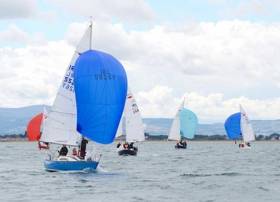Displaying items by tag: Puppeteer
Howth’s “Secret” Puppeteer 22 Class Launch Into Celebration Of Forty Years With HYC
In recent years, the large and varied membership of Howth Yacht Club have seen so many major anniversaries come and go – after proper programmes of lively celebration afloat and ashore – that casual observers might expect an element of festival fatigue to be creeping in.
Not a bit of it. Last year may have seen the 125th Anniversary of the unique Howth 17 One Designs, with the highlight being a boisterous Cruise-in-Company to some of the choicest destinations in West Cork. But this year it’s the turn of the ultimate Sailing Secret Society to celebrate forty years as a recognised club class at the peninsular port, which they naturally insist we recognise as being in East Fingal rather than the usual off-hand designation of North Dublin.
For in sailing, there are secret societies, there are top secret societies, there’s the Forbidden City, and then there are the Howth Puppeteer 22s. These manageable little boats-with-a-lid may have originated with designer-builder Chris Boyd of Killyleagh in Strangford Lough in the 1970s. But by 1984 enough of them had found the sailing and racing waters off Howth to be so congenial to their needs and capabilities that the class has just grown and grown, until nowadays most of the Puppeteer 22s in active existence are with this one class in this one location.
 Trick or Teat (Alan Pearson & Alan Blay) will be defending her Puppeteer 22 National Champion status during 2024
Trick or Teat (Alan Pearson & Alan Blay) will be defending her Puppeteer 22 National Champion status during 2024
A WORLD OF THEIR OWN
And they seldom interact by going anywhere else, for Howth’s sailing area with its two islands of Ireland’s Eye and Lambay is its own maritime universe. But the outside world was given a glimpse into this mini-universe recently with the Puppeteer 22 Annual Dinner and Prize-giving in the HYC clubhouse. It behoves us to publish the official report in its entirety, with the observation that despite being One Design, like the Howth 17s the Puppeteer 22s diligently maintain a parallel handicap division.
BIGGEST KEELBOAT OD CLASS AT HOWTH
“The Dinner marked the start of the celebrations for the fleet’s 40th year as a standalone Class at Howth Yacht Club. During that time the Club’s fleet has grown from its initial four boats to being the biggest one design keelboat fleet at Howth, or indeed any Irish club. The first four were Snowgoose, Sanderling, Gannet and Ibis, three of them still in the same families, and they are still among the fastest in the fleet. It now counts 32 boats afloat with four more in HYC, currently either resting ashore or undergoing refurbs.
 Made for each other…..Puppeteer 22s with Ireland’s Eye beyond. Photo: HYC
Made for each other…..Puppeteer 22s with Ireland’s Eye beyond. Photo: HYC
2023 saw two additions to the fleet, Ms Emma (B Mohan) making a long journey by road from northern parts, while Pinocchio (J McMahon) made a relatively short but incident packed voyage from its previous abode in Malahide.
EACH BOAT TABULATED
A programme of birthday celebrations is planned for 2024 and the awards night saw it get underway when each boat was presented with an encapsulated sheet featuring a photograph of the boat sailing, and a list of its ownership history and record of successes. Gerry Sargent is ‘Mr Puppeteer’ in Howth YC and his records of each of the 54 boats, which were built in Northern Ireland to Chris Boyd’s design, is an invaluable archive of the history of a unique 32 county story of sailing success. Mary McDyer and Olibhe Ní Bhraonain are sharing the party planning, and the awards night was a fantastic start to the celebrations.
Twenty-four boats took part in Club racing in 2023 and, with 18 afloat on a number of the evenings, competition was keen. The three series over the summer and the short end of season Mini-Series were dominated by Yellow Peril (Murphy/Costello) and Trick or Treat (Pearson/Blay). In the scratch series, each enjoyed two wins and two runner-up positions while, in the handicap events, the four wins went to Odyssey (P&R Byrne), No Strings (T. Harvey) and Gannet (T. Chillingworth) with Blue Velvet (G. Kennedy) and Papagena (K&B Barker) getting on the prize winners’ list as runner-ups. The two Saturday Series were won by Odyssey and by WeyHey (I. Dickson).
 Always there or thereabouts – Yellow Peril (Neil Murphy& Con Costello) finished last season on a high. Photo: W M Nixon
Always there or thereabouts – Yellow Peril (Neil Murphy& Con Costello) finished last season on a high. Photo: W M Nixon
The undoubted star performer of 2023 was Trick or Treat which, apart from its share of success in Club racing, won the Lambay Races, National Championship and Autumn League to take a clean sweep of the three major Class events of the year. Outgoing Class Captain Paul McMahon thanked the sailors for supporting the Class and Club racing and congratulated the prizewinners. Club racing starts again on April 23rd and competition promises to be fierce with both newcomers and increasingly quick old-timers determined to challenge the 2023 dominance of Trick or Treat.
With plenty of other Puppeteer 22s still racing, particularly in Northern Ireland, the Howth fleet looks forward to welcoming their Classmates this summer to share the celebrations and sample the racing area that so well suits these beautiful and long-lived boats”.
After a season or three playing bridesmaid to the McMahon's restored 1978-vintage Puppeteer 22 Number 1 Shiggi-Shiggi, the hard chaws of Alan Blay and Alan Pearson and their team on the enthusiastically campaigned Trick-or-Treat finally came good at the weekend to lift the Puppeteer 22 Nationals title for the first time, despite many years in which they've been the best on the season-long scoreboard.
Trick or Treat sailed a remarkably consistent regatta, six races and never finishing outside the top two, with three firsts. Defending champions on Shiggi-Shiggi could not match that level of consistency and finished runner-up (also counting three firsts). The Murphy-Costello partnership on the ever-present Yellow Peril was rounding out the top three.
 Third overall went to the Howth YC Commodore Neil Murphy and Conor Costello partnership in Yellow Peril
Third overall went to the Howth YC Commodore Neil Murphy and Conor Costello partnership in Yellow Peril
The HPH handicap fleet was won by Nefertari, Dylan & John Murray; second was Garret May on Honeybadger, and third was Tim Chillingworth on Gannet. Interestingly, Tim brought Gannet to Howth 40 years ago, and she was one of the three founding boats of the Howth fleet back in 1983.
It says everything about how well the Chris Boyd-designed Puppeteer 22s have fitted in with the Howth scene, that the class can count founder members still racing after forty years. But with a sensible eye to the future, for the first time, the class presented a prize to the top under-25 team, and this was claimed by Matthew Knowles on Interceptor.
An event like this can’t run without a lot of work behind the scenes; we are very lucky to have the support of Sutton Cross Pharmacy, access to a top-class race management team led by Harry Gallagher, a great rescue team and the support of Howth Yacht Club.
 The re-born Shiggi-Shiggi finally relinquished the title for the first time since her restoration
The re-born Shiggi-Shiggi finally relinquished the title for the first time since her restoration
Report by Paul McMahon
Title Retained In Howth’s Puppeteer 22 Champs Of Mixed Weather
Howth is squaring up to its 40th Autumn League this weekend – sponsored by Beshoff Motors – so recent weeks have seen various classes completing their own programmes, and last weekend’s Puppeteer 22 Championship sponsored by Sutton Cross Pharmacy was another event with a distinctly local flavour; in this case reflecting the vigour of a versatile class which provides excellent value.
With the forecasts for Sept 10/11 indicating no wind on Saturday and rather too much on Sunday, the Puppeteer fleet of 17 boats had low expectations for any racing as they motored towards the race area off Portmarnock on Saturday morning. The bright sunshine gave plenty of opportunities to admire the leftover sea that two weeks of strong easterlies had left behind, but the conditions offered little hope of anything but a suntan.
By the scheduled time of the first gun, Race Officer Harry Gallagher was offering the fleet the hope of some wind after a short postponement, and his fortune-telling skills were proved correct when a light breeze arrived again from the east. The spring tides of the weekend added a further complication to Harry’s task, and he decided on a triangle/sausage layout for the initial races to minimise the impact of the current. Although each day of the event had 3 races scheduled, the forecast for Sunday made it imperative to get in as many as possible on Saturday in the expectation of a lie-on in bed being the only option for the second day.
 …….while Day 2 was a real taste of Autumn, with Gold Dust ( Neil Murphy & C Costello) getting up to speed
…….while Day 2 was a real taste of Autumn, with Gold Dust ( Neil Murphy & C Costello) getting up to speed
With Shiggi Shiggi (P and L McMahon) having won in both 2020 and 2021, their win in Race 1 left no doubt about their intent for 2022, even though they just pipped Harlequin (David Clarke) on the line, David being back on top form after his two-year break. The sea conditions and light breeze placed a premium on speed, shift spotting and keeping the boat moving through the lump, and the two leaders’ one-minute gap over the third-placed Trick or Treat (Alan Pearson/Alan Blay) showed that they had the attributes needed.
In Race 2, the leaders swapped places and it was beginning to look ominous for the other title contenders, although Gold Dust - borrowed for the event by former Class stalwart Rob Stanley - grabbed third place to show that he has lost none of the skills that kept him at the front of the Howth fleet for many years in his former boat Mojo.
Race 3 saw the deck chairs shuffled as Trick or Treat took the gun from HoneyBadger (Garret May) while Shiggi Shiggi had to make do with a third and Harlequin struggled to 8th after losing a halyard up the mast just before the start.
With the original race quota complete, the Race Officer decided to press on with racing and for Race 4, the wind had freshened to around 7 knots, enough to allow the fleet race a Windward Leeward course. The extra breeze and the knowledge that this might be the last race of the event saw the over-anxious fleet went hit the line early and on the restart, under a U flag, both Honey Badger and Gold Dust earned themselves UFD scores.
A close race ensued, with the runs being where the main action took place and the leading four boats swapping places repeatedly. Yellow Peril (N Murphy / C. Costello) recovered their earlier lead on the last beat to grab first place on the line by just 60cm from Shiggi Shiggi with Trick or Treat and Harlequin following. As the fleet headed ashore with different race winners for each of the four races, the overnight leaders were Shiggi Shiggi with Harlequin and Trick or Treat joint second and Yellow Peril in 4th, just four points separating the top four.
 Puppeter 22 No 1 Shggi Shiggi (P & L McMahon) lived up to her senior ranking by making it three in a row for the title
Puppeter 22 No 1 Shggi Shiggi (P & L McMahon) lived up to her senior ranking by making it three in a row for the title
Sunday brought the change in weather that the forecasts had flagged and, although the rain arrived early, the wind strength was still manageable enough to encourage the RO to try at least one race. The gusting south easterly and pouring rain made Saturday’s Mediterranean conditions a fading memory. The fleet showed its intent to get full value from the change in conditions (or get ashore early) with another general recall.
The U flag restart resulted in bad news for some, with overnight leader Shiggi Shiggi and repeat offenders from Race 4, HoneyBadger and Gold Dust, being sent to the naughty step. Shiggi Shiggi was left to spectate on the race in the knowledge that it could well be the last one sailed and, in that case, a win for Harlequin would see Dave Clarke regaining the title that he last won in 2016. Things were looking grim for the overnight leader as Harlequin led the fleet around the first leeward mark but Yellow Peril rescued her day by taking the lead on the second beat and then extending to a comfortable victory with Harlequin back to second and Trick or Treat and WeyHey (Ian Dickson) following.
 Champions again – Paul & Laura McMahon with Shiggi-Shiggi’s successful crew
Champions again – Paul & Laura McMahon with Shiggi-Shiggi’s successful crew
With the Committee Vessel seeing gusts of 30 knots and the rain coming down in torrents, the Race Officer displayed N over A and that was that for another National Championships. Shiggi Shiggi took the title by one point from Harlequin and, a further point behind, Yellow Peril took third place from Trick or Treat on a tie break – possibly the tightest result in Pup history with the two-point gap separating the first four places. In the handicap event, Snowgoose (Sarah Robertson) took first ahead of Odyssey (P & R Byrne) and WeyHey.
 Sarah Robertson and the HPH winning crew of Snowgoose
Sarah Robertson and the HPH winning crew of Snowgoose
Class Captain Mary McDyer hosted a very enjoyable prize giving in the Clubhouse amidst the bedlam of a 150-boat Optimist regional championship that was sharing the HYC facilities for the weekend. The 17 boat entry is the biggest fleet since 2019, the last year before a ‘significant intervention’ to going racing – and life in general - got underway, and the Class now looks forward to an even bigger turnout for the Beshoff Motors Autumn League, which starts on Sept 17th.
McMahons Retain Puppeteer 22 Nationals at Howth Yacht Club
It was considered good going in the brief season of 2020 when Paul and Laura McMahon's 1978-vintage prototype Puppeteer 22 Shiggi Shiggi (sail number #1) emerged fresh but untried from the restoration laboratories and took the national title.
But in making their 2021 defence in a six-race series over this past sunny weekend in Howth, the McMahon boat by no means had it all her own way. In fact, the overnight leader after some highly photogenic competition in quite a decent sea breeze on Saturday was Trick or Treat (Alan Pearson & Alan Blay), and it was only by the third race that Shiggi Shiggi appeared to have found her mojo hidden in the back of a locker or wherever, waiting for its full deployment to win that particular contest from Scorie Walls in Gold Dust, with Trick or Treat in third.
 On course for history – the leading Puppeteers head for the Portmarnock Mark, close under Portmarnock House, the former home of the legendary Jameson sailing (and whiskey) family. In the right foreground are Odyssey (#50, P & R Byrne) and Inter-Scepter (#34, Simon Knowles, which was restored in a 300-hour lockdown refurbishment project). Photo: Annraoi Blaney
On course for history – the leading Puppeteers head for the Portmarnock Mark, close under Portmarnock House, the former home of the legendary Jameson sailing (and whiskey) family. In the right foreground are Odyssey (#50, P & R Byrne) and Inter-Scepter (#34, Simon Knowles, which was restored in a 300-hour lockdown refurbishment project). Photo: Annraoi Blaney
 HYC Vice Commodore Neil Murphy at the helm of Yellow Peril was among those vying for a podium place. Photo: Annraoi Blaney
HYC Vice Commodore Neil Murphy at the helm of Yellow Peril was among those vying for a podium place. Photo: Annraoi Blaney
Other who'd shown well in the first day included HYC Vice Commodore Neil Murphy helming Yellow Peril, and the May/Burke combo in Honey Badger. But on Sunday, Shiggi Shiggi took decisive control with three wins, and in the circumstances, the interest lay in who came second. Trick or Treat's Saturday success stood the Pearson/Blay team to the good, they were runners-up four points clear ahead of Gold Dust.
 Winner trim. Shiggi Shiggi looking every inch a champion as she races through Howth Sound past the Martello Tower on Ireland's Eye. Photo: Annraoi Blaney
Winner trim. Shiggi Shiggi looking every inch a champion as she races through Howth Sound past the Martello Tower on Ireland's Eye. Photo: Annraoi Blaney
Shiggi Shiggi was going so fast that she even overcame the HPH handicap system to win on that as well, but other names came onto the podium, second going to Mr Punch (Ni Bhraonain Wilson) and third (on a tie break) to P & R Byrne's Odyssey – details here
 Paul McMahon and his winning crew have just crossed the final line….. In the weeks ahead, it may take a real effort of memory to recall that for a magic time in 2021, we sailed in temperatures like this. Photo: Annraois Blaney
Paul McMahon and his winning crew have just crossed the final line….. In the weeks ahead, it may take a real effort of memory to recall that for a magic time in 2021, we sailed in temperatures like this. Photo: Annraois Blaney
First Three Sail Deliveries in 2021 for North Sails Ireland
A Happy New Year everyone from all of us here in North Sails Ireland!
Fingers crossed that the next few months will see a brighter future for us all and our sport that we love. Here at North Sails we are working assiduously and responsibly behind the scenes to help make this a reality.
We took the liberty of personally delivering some new sails to customers who were unable to collect them due to the 5km restriction. Fully masked and sanitised, we dropped some Water Wag sails to Rathmines and two sets of Puppeteer sails to Howth.
It was a delight to unroll Sarah Robertson's new GN-1B genoa in her garden yesterday. Her GN-1B is manufactured in premium RSQ 5.55 hard finish "Polykote" racing polyester manufactured by Contender. The finishing detailing on the sail is superb - congratulations to our wonderful sailmakers on the loft floor and our lead designer in our one-design group, Ruairidh Scott.
Sarah is the daughter of PRO doyen David Lovegrove and her Puppeteer "Snowgoose" has been in the family for many years. I may have team-raced against Sarah in the 90's - that's all a bit hazy but I look forward to a race with Sarah and her team in 2021 - if they'll have me!
North Sails have been involved in the P22 class in Howth since 2009 and I have had the pleasure of competing in some fantastic races there whilst helping teams get their Pups up to speed.
 2019 Puppeteer Nationals winner "Yellow Peril", skippered by former ISA President Neil Murphy. Yellow Peril is flying her North Sails PM-1 spinnaker manufactured in A GRADE Contender Superkote and her PM3 mainsail manufactured in Contender RSQ Polykote 6.05 polyester. Photo: WM Nixon
2019 Puppeteer Nationals winner "Yellow Peril", skippered by former ISA President Neil Murphy. Yellow Peril is flying her North Sails PM-1 spinnaker manufactured in A GRADE Contender Superkote and her PM3 mainsail manufactured in Contender RSQ Polykote 6.05 polyester. Photo: WM Nixon
 Scorie Walls and Declan Browne's Gold Dust finishing 2nd overall in the 2017 Nationals - powered by North Sails
Scorie Walls and Declan Browne's Gold Dust finishing 2nd overall in the 2017 Nationals - powered by North Sails
Keep in touch everyone and best wishes from us here at North Sails Ireland.
Yellow Peril is Top Dog Among the Puppeteers After Marathon National Championship
One of the most publicity-shy classes in the entire country is also one of the most successful at club level writes W M Nixon. They’re the Puppeteer 22s at Howth. In all, the peninsular port has around 25 of these very handy fractionally-rigged sloops, which originated in Strangford Lough from 1978 onwards, but nearly all have now gravitated to Howth. Their enthusiasm is indicated by the fact that seventeens boats with their crews of four (sometimes five, sometimes three) signed up for the marathon eight-day 2019 Nationals, and all seventeen were still racing at the end.
The class seldom if ever ventures from the racing areas at its home port, where it’s a by-word for ease of handling with good sport - and all in a neatly affordable package. While their racing is at a very determined level, they don’t take themselves too seriously, as they seem happy to be known as “The Pups”. And they’ve a refreshingly politically incorrect approach to the names that some of their boats carry. However, as the class has been around for a while, in many cases they inherited those names, and Puppeteer crews share the old sailors’ superstition that boat names shouldn’t be changed for fear of it bringing bad luck, regardless of PC attitudes.
The eight day Puppeteer Nationals 2019 at Howth (where else?) ran from Saturday August 24th to Saturday August 31st. Now admittedly they took a break off racing from Sunday August 25th until Friday August 30th, to permit Sabbath observation and a return to a week’s work or other duties. But for Saturday August 24th and the following event-concluding Saturday, Howth YC was dressed overall in championship finery, and the breezes were great for a total of six intensely fought race races, three each day.
Over the season as a whole, Algy Pearson & Alan Blay’s Trick or Treat has tended to be top boat. But for the Nationals, former ISA President and serial Race Officer Neil Murphy and his co-owner Conor Costello in Yellow Peril were on a winning streak which lasted for the entire eight days. Their scoreline of 1,1,2,(4),3,2 speaks for itself. But though after the single discard they topped out with 9 points to the 15 of Dave Clarke, his Harlequin had three firsts and that six points gap was usually a matter of seconds out on the water. Third was Gannet (T Chillingworth) on 16, as were the Hegarty brothers’ Eclipse, and Trick or Treat, but the countback gave it to Gannet while Eclipse and Trick or Treat had fallen from stronger positions through failing to finish in the big breeze of the final race, making for a punishing discard.
As for the prize-giving dinner last Saturday night, the class’s official report gives a flavour of this quietly-successful local phenomenon:
“The well-attended prize giving dinner in HYC first dealt with the mundane distribution of silverware to the successful before moving on to the presentation of the serious awards for the Championship - most spectacular collision (Crunchie trophy), broach of the event (Andrex trophy) and man overboard trophy (fishing net). The top award of the evening - and one only presented on rare occasions - is for the most enthusiastic grounding (beach bucket and spade), with the trophy this year going to a boat that spent an entire race (and a little extra) looking at the sea bottom getting ever closer to them. The award winners’ modesty (and discretion) prevents their identification, but their good humour in adversity was a credit to them all”.
Now here’s a thought. If anybody has ever commented on the fact that the designer of Howth’s most iconic class happens to have the same surname as Chris Boyd, the designer of the always-keen Puppeteer 22s, then they’ve never made much of it.
Yet in Howth Yacht Club, there’s a Boyd Room filled with memorabilia related to Herbert Boyd, designer in 1897-98 of the Howth Seventeens. Surely a corner could be found in the Boyd Room for something about Chris Boyd (no relation), who these days sails a Laser from Ballyhome, and is no longer in the boat business. But at the time he was designing and building boats, he tangentially made an enormous and lasting contribution to Howth sailing.
Success for 'Blue Velvet' & North Sails at the Puppeteer National Championships at Howth Yacht Club
North Sails-powered "Pups" took 1st, 3rd and 4th overall at the Puppeteer 22 Irish Championships held in Howth Yacht Club on July 28/29.
Long-time North Sails Ireland clients Colin and Kathy Kavanagh in "Blue Velvet" won the title for their second time.
Former ISA president Neil Murphy with co-owner Conor Costello in "Yellow Peril" finished 3rd overall counting two first places in his scoreline.
Maurice O'Connell from North Sails Ireland, speaking after the event said, "once again our Pup clients did us proud in the Nationals in Howth. We have been developing our class designs since 2009 and are delighted with our clients' speed and consistency across the wind range. Well done to everyone involved and roll on the Autumn Series!".
Much more on the championships on the HYC site here.
North Sails Results
1. "Blue Velvet" Colin & Kathy Kavanagh 8 pts - North Sails
3. "Yellow Peril" Neil Murphy & Conor Costello 13 pts - North Sails
4. "Gold Dust" Scorie Walls & Declan Browne 16 pts - North Sails
6. "IBIS" Susan Sheridan 28 pts - North Sails
Puppeteers Prepare for National Championships
The Sutton Cross Pharmacy Puppeteer 22 National Championship 2016 takes place in Howth Yacht Club over the weekend of the 30th. and 31st. July.
This class provides very close midweek racing in HYC, with 20 odd boats out on Tuesdays. Harry Gallagher is Race Officer. Six races are scheduled, three on each day, with first warning signals at 11.00.
With several previous National Champions attending there is no clear favourite as to who will emerge as the 2016 Champion, according to Class Captain Kieran Barker of Howth.
Local Sailing Class Success Takes Good Boats, But Even Better People
As we near the end of the traditional sailing season, inevitably there’ll be heart-searching among boat owners as to the success and value obtained from their summer afloat – can they really justify the expense of continuing to keep a boat? And with so many imponderables in our sport after a summer which was decidedly mixed in its weather - to say the least - the larger sailing community will be scrutinising those classes which seem to be barely hanging in, those classes which are doing quite well, and those few classes which are spectacularly successful. W M Nixon takes a look at the International Dragons in Glandore, the Flying Fifteens in Dun Laoghaire, and the Puppeteer 22s in Howth to try and find that magic Ingredient X which helps - or has helped - these three very different examples to stay ahead of the game.
The wish to own a boat is a vocation, a calling, a quasi-religious emotional endeavour. It’s all very well for high-flown consultants to tell us that if sailing is going to have general appeal and expand, then publicly-accessed freely-available try-a-sail boats will have to be based at every major club. But dedicated sailors know that what comes easy, goes easy. A spell of bad weather, and your jolly public groups who turned up in droves for a bit of free fun afloat will disappear like the will-o’-the-wisps they were in the first place, seeking instead to find somewhere warm and bright and out of the rain and readily providing the latest novel form of entertainment.
Meanwhile, those who are dyed-in-the-wool boat addicts will have barely noticed the idly-interested strangers coming and going. For whatever the weather, they’ve a boat to maintain, gear to repair, a crew to keep together, and some sensible purpose to find in order to give it all deeper meaning. For they know that unless they’ve a boat and her problems and possibilities occupying a significant part of their mind, they’re going to lose the plot completely.
Nevertheless, in the huge spectrum of boat ownership and sailing classes, why is there so much difference in the successful buzz created by some classes at certain localities, as opposed to the dull and declining murmur emanating from classes which are clearly on the way out?
After all, there are very few utterly awful boats afloat. No boat is completely perfect, though some may seem less imperfect than others. But in today’s throwaway world, if some class of boat is not a reasonably good representative of her general type, then she’ll never make the grade in the first place. And even in times past when news and views moved more slowly, the word soon got around if some much-touted type of boat was in truth a woofer.
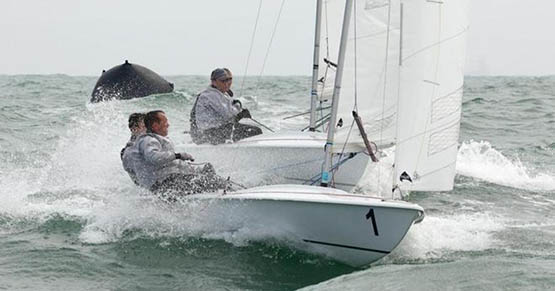
Flying Fifteens provide the best of sport in a very manageable two-man package

The perfect harbour for vintage International Dragons – Glandore, with a goodly selection of classics in port, and Dragons of all ages dotted among them
That said, boat-owning is such an all-consuming passion that once a sailor has finally (or indeed hastily) committed to a particular boat type, then he or she will tend to be absurdly dismissive of any remotely comparable craft. But in the last analysis, the desire to own a boat is irrational. So we shouldn’t be surprised that once the decision is made, irrational attitudes manifest themselves in every direction.
And anyway, as John Maynard Keynes once remarked in a totally different context, in the last analysis we are all dead. So in the meantime, it behoves us to get as much reasonable enjoyment out of life as possible. Thus if owning and sailing a boat is your way of obtaining pleasure without harming anyone else, then good luck to you and me, and let’s look together at boat classes which are doing the business.
In considering the International Dragons in Glandore, the International Flying Fifteens in Dun Laoghaire, and the emphatically not-international Puppeteer 22s in Howth, we are indeed casting the net wide, for really they couldn’t be more different. The 29ft International Dragon originated in the late 1920s from the design board of Johan Anker of Norway, and she has become a by-word for Scandinavian elegance in yacht design, but today she’s totally a racing machine and has strayed far from her original concept as a weekend cruiser for sheltered waters.
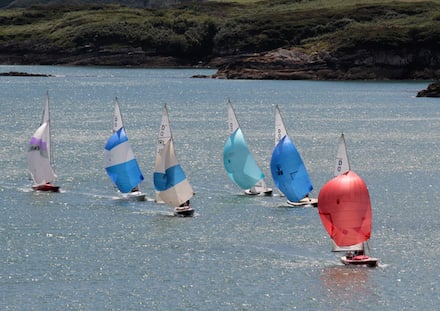
Golden days of classic Dragon racing at Glandore
As for the Flying Fifteen, they originated from designer Uffa Fox having a brainstorm in 1947, in that he took the underwater hull section of the renowned International 14 dinghy in which he was something of a master both as designer and sailor, but above the waterline he drew out the bow to an elegant curved stem, then he lengthened the gentle counter lines to finish in a long sawn-off transom. That done, he added a little hyper-hydrodynamic bulb ballast keel which seemed very trendy, but in truth it’s severely lacking in useful lateral resistance. Nevertheless it gives the boat the reassuring feel of being a small keelboat rather than a big dinghy, and atop it all he put the rig of an International 14 dinghy of that era.
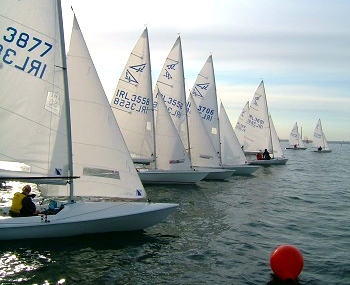
The clean lines of a modern Flying Fifteen fleet. Try to imagine that within each hull there’s an International 14 dinghy, and above it is the original rig
The result was a boat which is really only useful for racing, and it is a design so much of its times that it’s said that many years later the designer himself tried to disown it. But the owners would have nothing to do with this, they liked the compact and very manageable racing-only package which the Flying Fifteen provides, and these days the class has an interesting world spread, and an attractive policy of staging their World Championships at agreeable sunshine destinations where – thanks to their guaranteed ability to turn up with a fleet of viable size – they can arrange block discounts to provide the owners with a very appealing package.
After the sheer internationality of the Dragons and the Flying Fifteens, the Puppeteer 22s are something of a culture shock, as almost every one in existence has ended up based in Howth, where they have such a busy club programme that they only very seldom go south of the Baily, though they do have one annual adventure to Malahide for the Gibney Classic, and once a year they take part in the historic Lambay Race. But otherwise, they’re totally and intensely focused on club racing off Howth.

The Puppeteer 22s seldom stray far from their home port of Howth, for at home they get superbly close racing with a fleet of up to 26 boats in evening racing. This is former ISA President Neil Murphy racing hard at the helm of Yellow Peril, neck and neck with Alan Pearson’s Trick or Treat. Photo: W M Nixon
They were designed by Chris Boyd of Strangford Lough in the mid 1970s to be fractionally-rigged mini-offshore racers, and in all about thirty-three of the Puppeteer 22s were built by C & S Boyd in Killyleagh (Sarah was Chris’s wife). For a while it looked as though they might take off as a semi-offshore One Design class in the north, but somehow they began to trickle down to Howth. They appealed to those sailors who felt that the alternative of a Ruffian 23 with her huge masthead spinnaker was a little too demanding on crews, whereas the Puppeteer’s fractional rig is fairly easily managed. And today the class in Howth is in such good health that even in the poor weather of 2015 they were obtaining regular midweek evening racing best turnouts of up to 26 boats.
Obviously the Puppeteer 22s are now very much a completely localised phenomenom. But while the Flying Fifteens in Dun Laoghaire and the Dragons in Glandore may be representatives of well-established international classes, the fact is in both cases their neighbourhood success is largely due to a distinct local flavour driven by individual enthusiasm. And in Glandore while it’s recognized that the vintage Dragon class was started by Kieran and Don O’Donohue with the classics Pan and Fafner, the man who beats the drum these days for the racing at Glandore as providing “the best and cheapest Dragon racing in the world” is the inimitable Don Street.
Most people will expect that they will be slightly older than the boats they own, and the older you get the greater you’d expect the age gap to be. But Don’s classic Dragon Gypsy is 82 years old. Yet Don himself manages to be that proper little bit senior to her, as he’s 85 and still full of whatever and vinegar, as they’d say in his native New England.
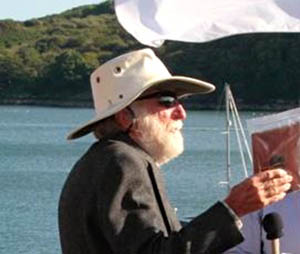
The one and only Don Street in his beloved Glandore. His International Dragon Gypsy is 82 years old, but he still manages to be the senior partner at 85.

Conditions are pleasantly sheltered for the Dragons in Glandore Harbour, but when the fleet goes offshore – as seen here for last year’s championship - they can find all the breeze and lively sea they might want, and more.
The things that Don has done with Gypsy – between intervals of the renowned ocean voyaging with his 1905-built yawl Iolaire which he has now sold – are remarkable, as he sailed Gypsy from Glandore to the classic regatta in Brittany, which is a prodigious offshore passage for an open cockpit racing boat along what the rest of the world would see as significant portions of the most exposed parts of the Fastnet Race course.
Yet although he did such wonderful business with Gypsy on great waters, he has no doubt that the secret of Glandore Dragon racing’s local success is the sheer nearness and convenience of it all. “Down to the pier and out to the boat in five minutes, the starting line is right there, and we don’t race those boring windward-leewards, rather we use club buoys, government navigation marks, islands - and lots of rocks……”
His argument is that with lovely Glandore Harbour being such an fascinating piece of sailing water, part of the interest in keeping up the pace in a local class lies in using those local features, rather than pretending they simply don’t exist by setting courses clear of the land. But of course when the Glandore fleet – which continues as a mix of classic wooden and glassfibre boats – hosts a major event such as last year’s Nationals – which was won by Andrew Craig of Dun Laoghaire in Chimaera – then the courses are set in open water, and they’d some spectacular sailing with it.
In many ways Glandore is a special case, as the population swells in summer with people coming for extended vacations. When that’s the case, their commitment to local Dragon racing can be total, and not least of the occasional local summertime alumni is the great Lawrie Smith. He may have won the Dragon Gold Cup from a fleet of 66 boats last month in Germany under the burgee of another club, but when he’s racing Dragons in Ireland, he’s emphatically under the colours of Glandore Harbour Yacht Club.
Despite these glamorous international links, it’s the folk on the home ground with their dedication to the Dragon Class in Glandore who keep it all going, and it’s Don Street with his dogged determination to prove you can run a Dragon out of pocket money, regardless of the megabucks some might be ready to splash out, which gives the Glandore Dragons that extra something. And in the end it’s all about people, and shared enthusiasm. If you’ve a warm feeling about the Dragon class, and particularly for classic boats in it, then you know that in Glandore you’ll find fellow enthusiasts and every encouragement.
But up in Dun Laoghaire, if you take a look over the granite wall on to the east boat park at the National Yacht Club in summer, and see there the serried ranks of apparently totally identical Flying Fifteens all neatly lined up on their trailers, you could be forgiven for thinking it’s all just ever so slightly clinical, and certainly distinctly impersonal.
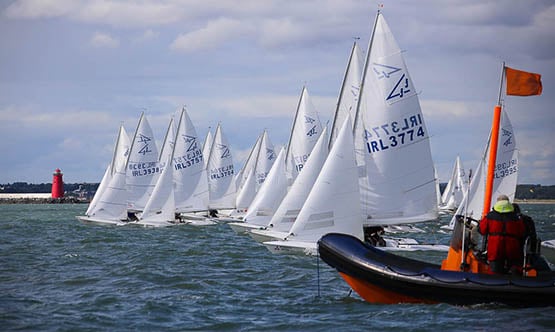
Just about as one design as they could be – the fine fleet at last weekend’s Flying Fifteen Irish Championship in Dublin Bay showed the vigour of the class, which has 47 ranked helmsmen in this country.
Yet you couldn’t be more utterly wrong. Today’s Flying Fifteens may have been technically refined to the ultimate degree to give maximum sport for the minimum of hassle. But their current runaway success – they’re far and away the biggest keelboat One Design class in Dublin Bay – is down to a friendly and very active local class association, and its readiness to reach out the hand of friendship and encouragement to anyone who might be thinking of joining the class’s ranks.
Recently the pace has been set by class captain Ronan Beirne, who recognises that simply announcing and advertising an event is not enough. You have to chivvy people and encourage them into their sailing – particularly after a summer remembered as having had bad weather – and then far from sitting back and smugly counting numbers, you have to keep at it, seeing that crewing gaps are filled, and that those on the fringes are brought to the centre.
The Flying Fifteens – which are essentially a National YC class – offer exceptional value and a very manageable package. The boats are dry-sailed in their road trailers, and instead of queuing for a crane, they have a rapid rota of slip-launching, with the expectation of renewing the wheel bearings each year. Salt water and road trailers are not good partners, but in order to ensure the most efficient launching and retrieval of the boats after each day’s racing, replacing wheel bearings has become something of an art.
The class in Dun Laoghaire secured good sponsorship from Mitsubishi Motors at the beginning of the year, and the sponsors in turn have been rewarded by a thriving class in which inter-personal friendships have developed to such a healthy state that you might find people crewing for someone who would be a complete and untouchable rival at other times in many other classes, but in the Dun Laoghaire Flying Fifteens he’s a fellow enthusiast who happens to be short of a crew on that day.
One of the enthusiastic newcomers to the class this year is Brian O’Neill, who originally hailed from Malahide and was best known for campaigning the family’s Impala 28 Wild Mustard with great success for several years, but now he’s very much a family man living in Dun Laoghaire with three growing kids, and sailing had gone on to the back burner.
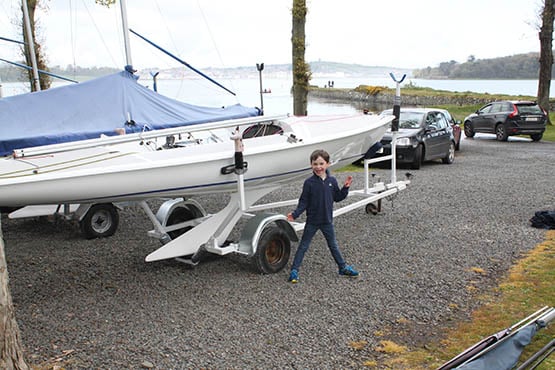
Charlie O’Neill (aged 7) at Strangford SC with dad Brian’s newly acquired Flying Fifteen. Under the rapid moving launching system at the National YC, the dry-sailed Flying Fifteens use their road trailers to get the boats afloat in record time. The need for regular replacement of the wheel bearings is allowed for in each boat’s budget. Photo: Brian O’Neill
But as the National YC is just down the road from where he lives, he was drawn into its welcoming ambience, and soon became aware of the attractive and friendly package offered within the club by the Flying Fifteens. He bought one in good order from an owner at Strangford Sailing Club in the Spring, and was soon in the midst of it. Yet it takes up only a very manageable amount of his time, it simply couldn’t be more convenient, and the people are just great too.
Who knows, but having won the class’s last evening race of the 2015 season, he might even be prepared to travel to maybe one event at another venue in Ireland. But the primary attraction continues to be the class’s strong local ethos and ready racing at the National, the friendliness of fellow Flying Fifteen sailors, and the sheer manageability of the whole thing – this is not a boat where the ownership gets on top of you.
If you want to get the flavour of Dun Laoghaire Flying Fifteen racing, you get a heightened sense of it from the report in Afloat.ie of how David Gorman and Chris Doorly won last weekend’s Irish championship in classic style, and if this isn’t good value in sailing and personal boat ownership, then I don’t know what is.
Across Dublin Bay in those misty waters of Fingal beyond the Baily, your correspondent found himself reporting aboard Alan “Algy” Pearson’s Puppeteer 22 Trick or Treat last Saturday for the opening race of the MSL Park Motors Autumn League. I did so with some trepidation, for Alan has a super young crew recruited from Sutton Dinghy Club in the form of GP14 ace Alan Blay, Ryan Sinnott and Claud Mollard, but our cheerful skipper said that as the day was brisk, they needed the fifth on board for ballast.
In fact, I’d only once raced a Puppeteer before, in the lightest of winds when somehow we managed a win. But as this race progressed with the skipper and his young tacticians making a perfect call for the long beat in a good long course which made full use of the splendid sailing waters north of Howth, by the last leg after many place changes it looked as though another win might be on the cards.

Action stations. Puppeteer 22s closing in for their start. Photo: W M Nixon
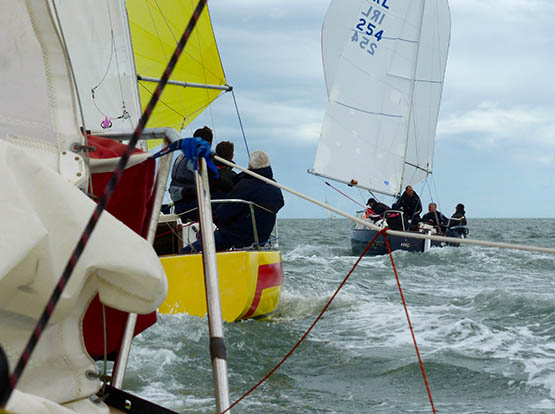
At mid-race, Gold Dust led narrowly from Yellow Peril, but by the start of the last beat, Trick or Treat was leading from Gold Dust with Yellow Peril third. Photo: W M Nixon
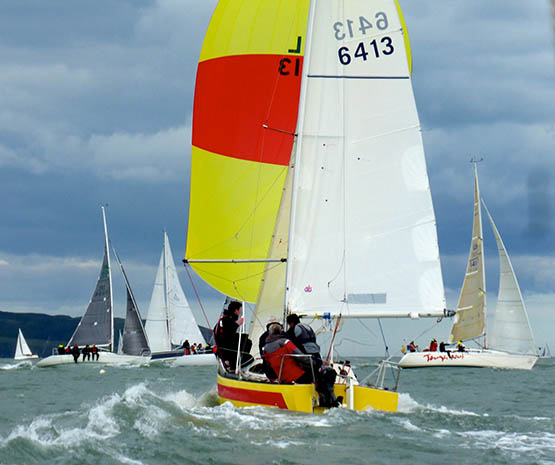
In the MSL Park Motors Autumn League, the mix of classes can sometimes make for interesting situations. Having out-gybed Gold Dust, Yellow Peril is ploughing towards some biggies on another course altogether, and meanwhile there’s the inevitable lobster pot lurking on the way with just one tiny white marker buoy. Photo: W M Nixon
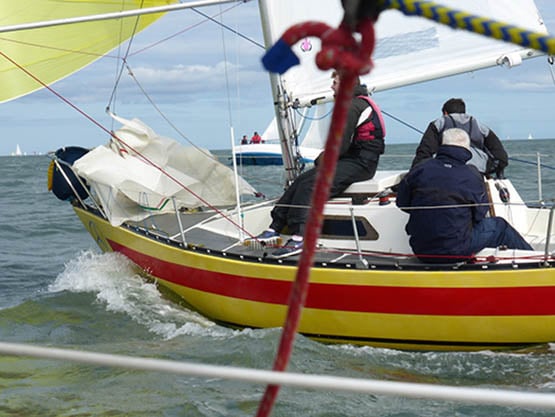
Algy Pearson’s Trick or Treat giving Yellow Peril a hard time to snatch the lead, which she then increased with a cleverly-read long beat. Photo: W M Nixon
But the pace in the Puppeteers is ferocious, and though we’d got a bit of a gap between Trick and former IDRA 14 empress Scorie Walls in Gold Dust, one sneeze from us and Gold Dust would pounce, and alas - we sneezed.
As long as we were carrying the no 2 headsail (what I’d call the working jib) we were level pegging with the formidable Walls-Browne team. But Gold Dust has a lovely new suit of sails (nice ones, Prof), and when the easing wind meant we’d to change up to the genoa, it emerged as a sail of a certain age, and having it set sapped our confidence.
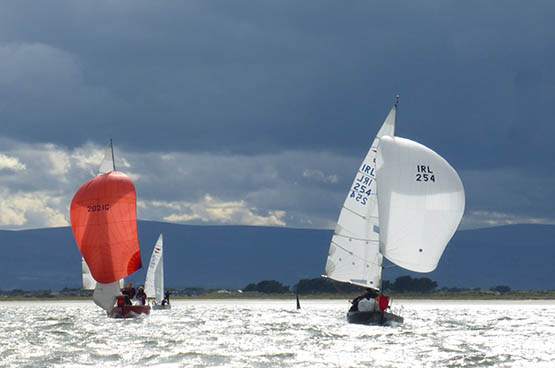
It looked for a while as though Gold Dust (254) had been put fairly comfortably astern……..Photo: W M Nixon
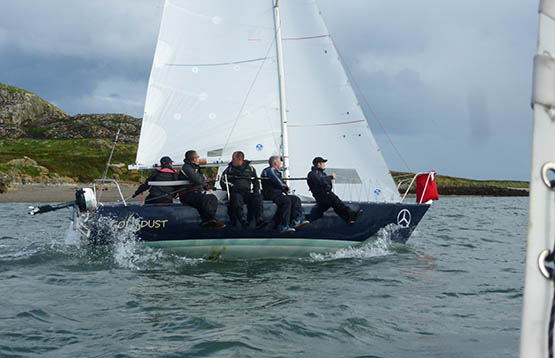
……but an easing of the wind saw Gold Dust finding new speed, and with perfect tactics she was right there with just a hundred metres to go to the finish. Photo: W M Nixon
Until then, the boat had been sailed magnificently, tactics right, trim right, and throwing gybes with such style that the downwind pace never missed a beat. But trying to get that genoa right was a mild distraction, so when Scorie the Queen of the Nile came round the final mark to chase us up the last beat to weather Ireland’s Eye, we’d failed to throw a precautionary tack to keep a loose cover, and suddenly as she rounded she found a local favourable but brief shift of 15 to 20 degrees, and then it was all to play for.
Dissecting it all afterwards (you’ll gather it was a post mortem), we could see two places where we might have still saved the day, but we didn’t grab them, or maybe in truth they were beyond our reach. Whatever, Gold Dust was in the groove and we weren’t. Madam beat us by three seconds. But the banter afterwards and the evidence that Puppeteer people – owners and crews alike – move happily among boats to keep turnout numbers up, was ample proof that here was another truly community based class which perfectly meets a strong local need.

That winning feeling…..Gold Dust’s crew relax after taking first by three seconds. Photo: W M Nixon

The Howth experience. Howth YC Commodore Brian Turvey heads back to port after racing the MSL Autumn League with the Howth 17 Isobel which he co-owns with his brother Conor. Photo: W M Nixon
It had been a great day’s sport, and the Puppeteers being of an age and regularly turning out to race together, they run both a scratch and a handicap system, which is a great improver of local classes – after all, where would golf be without handicaps?
It shows how well Gold Dust has been going this year that her rating is such that we beat her on handicap by one minute and 19 seconds, but we in turn, having been second on scratch, were fourth on handicap, where the winner was the O’Reilly/McDyer team with Geppeto.
Forty years after they first appeared, the Puppeteer 22s are giving better sport than ever, but in a very local context rather than on the bigger stage that might have been anticipated. Yet for their current owners, they do the business and then some. For most folk, this is sailing as it should be. And as to this longterm success of classes which continue to thrive whether they come from a local, national or international background, certainly the quality of the boats is important to some extent. But mostly, it’s the people involved, and their realization that you’ll only get as much out of sailing as you put into it.
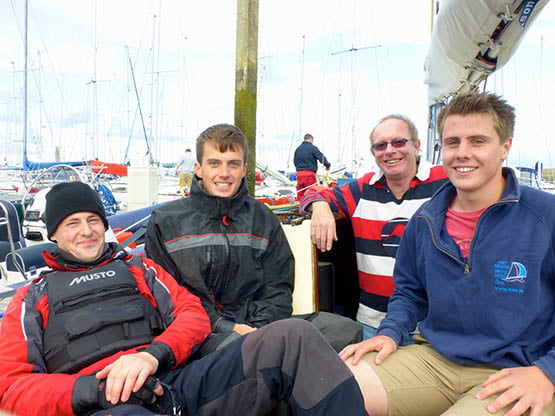
A super crew. Aboard Trick or Treat after racing are (left to right) Alan Blay, Ryan Sinnott, Alan Pearson and Claud Mollard. Photo: W M Nixon

Local man, local boat. Algy Pearson with his Puppeteer 22 Trick or Treat. The Pearsons have been sailng from Howth for three generations. Photo: W M Nixon
Puppeteer National Title Goes to Harlequin of Howth
#puppeteer – Racing was tight, challenging, and even described as 'chaotic' in the weekend's Puppeteer National Championships off Howth, in County Dublin.
Race officer Harry Gallagher got the best out of a range of trying conditions, and it was the 2011 winner Harlequin (Dave Clarke) who adapted best to the wide ranging conditions to take the national title from defending champion Robin Hegarty in Eclipse.
The Irish Puppeteer fleet is based exclusively at Howth Yacht Club with up to 20 boats racing regularly in club racing.































